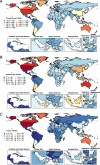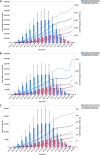Gout: global epidemiology, risk factors, comorbidities and complications: a narrative review
- PMID: 39702222
- PMCID: PMC11660718
- DOI: 10.1186/s12891-024-08180-9
Gout: global epidemiology, risk factors, comorbidities and complications: a narrative review
Abstract
Background: Gout is one of the oldest known diseases and the most common form of inflammatory arthritis. The established risk factors for gout include hyperuricemia, chronic renal disease, genetic, alcohol consumption, dietary factors, diuretic use, hypertension, obesity, and metabolic syndrome. Patients with gout have an increased risk of all-cause mortality, particularly from cardiovascular disease, cancer, and infectious diseases. Gout is also associated with several complications, such as nephrolithiasis. This literature review describes the global epidemiology and trends associated with gout, before providing an overview of its risk factors and complications.
Methods: This research used the narrative review method. Thorough searches were performed in PubMed and Google scholar, up to June 15, 2024, for articles that evaluated the risk factors, comorbidities or complications associated with gout. Moreover, we also included studies that reported the epidemiological characteristics or burden of gout at the global, regional, or national level.
Results: Gout is more prevalent in developed countries, than in developing countries, although its prevalence is increasing globally. In addition, gout is much more prevalent among males than among females. Hyperuricemia has the largest role in the development of gout, although many risk factors contribute to the increasing prevalence of gout, including genes, several medications, and diet. Gout is associated with several comorbidities and complications, which need to be taken into consideration when managing gout. In recent years, gout has been found to be associated with several new comorbidities.
Conclusions: Our findings provide a comprehensive and informative overview that can be useful for the prevention, diagnosis, and management of gout.
Keywords: Epidemiology; Global Burden of Disease; Gout; History; Hyperuricemia; Risk factor.
© 2024. The Author(s).
Conflict of interest statement
Declarations. Ethics approval and consent to participate: The present report was approved by the Ethics Committee at the Shahid Beheshti University of Medical Sciences (IR.SBMU.RETECH.REC.1401.216). Consent for publication: Not required. Competing interests: The authors declare no competing interests.
Figures



Similar articles
-
Epidemiology of hyperuricemia and gout.Am J Manag Care. 2005 Nov;11(15 Suppl):S435-42; quiz S465-8. Am J Manag Care. 2005. PMID: 16300457 Review.
-
[Gout and hyperuricemia today: prevalence, risk factors, features in the elderly].Adv Gerontol. 2012;25(3):540-4. Adv Gerontol. 2012. PMID: 23289237 Review. Russian.
-
Hyperuricemia, gout, and related comorbidities: cause and effect on a two-way street.South Med J. 2014 Apr;107(4):235-41. doi: 10.1097/SMJ.0000000000000082. South Med J. 2014. PMID: 24937517 Review.
-
Epidemiology of gout.Rheum Dis Clin North Am. 2014 May;40(2):155-75. doi: 10.1016/j.rdc.2014.01.001. Epub 2014 Feb 19. Rheum Dis Clin North Am. 2014. PMID: 24703341 Free PMC article. Review.
-
Comorbidities of gout and hyperuricemia in the US general population: NHANES 2007-2008.Am J Med. 2012 Jul;125(7):679-687.e1. doi: 10.1016/j.amjmed.2011.09.033. Epub 2012 May 23. Am J Med. 2012. PMID: 22626509
Cited by
-
Medication adherence and health empowerment in gout: a cross-sectional survey of patients.Rheumatol Int. 2025 Jul 24;45(8):176. doi: 10.1007/s00296-025-05915-2. Rheumatol Int. 2025. PMID: 40705117
-
Exploring the Impact of the Gut Microbiota/REV-ERBα/NF-κB Axis on the Circadian Rhythmicity of Gout Flares from a Chronobiological Perspective.J Inflamm Res. 2025 Jun 19;18:8141-8151. doi: 10.2147/JIR.S525351. eCollection 2025. J Inflamm Res. 2025. PMID: 40551987 Free PMC article. Review.
-
The Prevalence and Associated Risk Factors of Coronary Heart Disease in Patients With Gout: A Cross-Sectional Study.Cureus. 2025 Jun 1;17(6):e85194. doi: 10.7759/cureus.85194. eCollection 2025 Jun. Cureus. 2025. PMID: 40458383 Free PMC article.
-
Current Status of Gout Arthritis: Current Approaches to Gout Arthritis Treatment: Nanoparticles Delivery Systems Approach.Pharmaceutics. 2025 Jan 14;17(1):102. doi: 10.3390/pharmaceutics17010102. Pharmaceutics. 2025. PMID: 39861750 Free PMC article. Review.
-
The role of high large unstained cell percentages in ongoing inflammation in the intercritical gout.Jt Dis Relat Surg. 2025 Apr 5;36(2):366-372. doi: 10.52312/jdrs.2025.2188. Epub 2025 Apr 5. Jt Dis Relat Surg. 2025. PMID: 40235415 Free PMC article.
References
-
- Doherty M. New insights into the epidemiology of gout. Rheumatology. 2009;48(suppl_2):ii2-ii8. - PubMed
Publication types
MeSH terms
LinkOut - more resources
Full Text Sources
Medical

